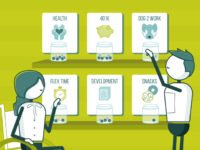You don’t need a large budget to create a good employee experience.
As technology evolves and we gain more insights into how we work, many companies are discovering there’s a considerable gap in how employees and leaders perceive their work experiences. When engagement reports reveal a majority of employees remain disengaged at work, leaders are often left wondering how to create a good employee experience.
But employee experience is more than just a rebranding of engagement. Employee experience considers the entire journey a person has with an organization—from their first awareness of the organization, through the hiring process, their tenure at the company, as well as the experiences they have when they leave a company and become an alumnus.
When you consider employee experience as a journey, it becomes clear how important it is to take a more holistic view, similar to the way design thinking focuses on user experience or marketing teams research customer experience. To improve employee experience, you must first understand what a work day looks like for your employees.
Walk in their shoes
If you don’t know what a day in the life of your cashier, nurse, or customer service representative looks like, just ask. Often the disconnect between leaders and employees occurs because of distance and lack of communication. Even if your leaders rose through your organization to their current positions, few of those jobs look the same today as they did ten or even five years ago.
Related: Improving the Employee Experience: Where Does It Start?
Before you can make improvements, you must understand where your organization is today. This means you may have to do some research to understand what employees experience during different phases of their career with your organization. Be sure your research includes new hires, those who are mid-career, those who are nearing retirement, as well as a cross-section of shifts, departments, and roles.
When researching you can use surveys, focus groups, employee interviews, or consider a day of job shadowing. The key is to be curious, empathetic, and avoid making assumptions. Acquire as much information as you can from employees about what they like about their jobs, what processes are helpful, and what would improve about their jobs.
Find the pain points
As you conduct your research, you may uncover some areas ripe for improvement. In his book “The Employee Experience Advantage,” Jacob Morgan states every employee experience is comprised of three environments: physical, cultural, and technological.
Ask specific questions about each of these areas to uncover what pain points employees experience on a regular basis. Understanding the most common frustrations employees face is an excellent way to create a plan for a good employee experience.
Think big, but start small to create a good employee experience
Now it’s time to start brainstorming solutions. If you break your research down into Morgan’s three environments, you may find one particular area has more pain points than others. Making adjustments to an environment with significant room for improvement can be a good way to see a positive impact quickly.
It’s often the little moments that have a significant impact on employee experience, whether positive or negative. These things may have easy, inexpensive solutions. Start by looking for a few small, actionable steps to improve first.
During your research, you may have discovered employees had suggestions to share, but didn’t know how to share them. Implementing a way for employees to submit unsolicited feedback doesn’t have to cost a lot, but can have a significant impact on how valued employees feel. Providing opportunities for improvement can lead to a good employee experience within your cultural environment.
Or you may have discovered the accounting team has to walk down the hall to another office to print quarterly reports because that’s the only color printer on their floor. This affects the employee experience in two of the three environments: technology and physical. A no-cost solution might be to relocate the color printer, or you may need to make a small investment in an additional one. By making printing more accessible, you’ll improve both environments with a single solution.
Of course, you may uncover more substantial issues during your research. Negative experiences within the technological environment may not always be easy or inexpensive to solve. You can add the more substantial improvements to a larger employee experience strategy to address in the future. However, by starting small and making low or no cost changes to improve the daily environment for employees, you can begin to improve employee experience sooner.
As Morgan points out, the majority of things that create a good employee experience are free. “What’s the cost of treating people well, giving them flexibility and autonomy, hiring a diverse group of people, and giving them the opportunity to learn and grow?” Morgan says, “How we treat our people is free.”



 3 min
3 min




